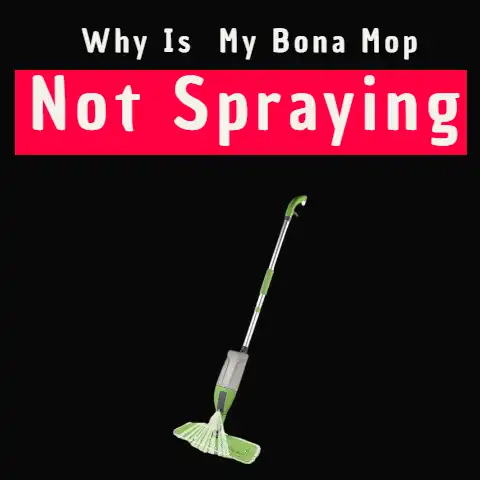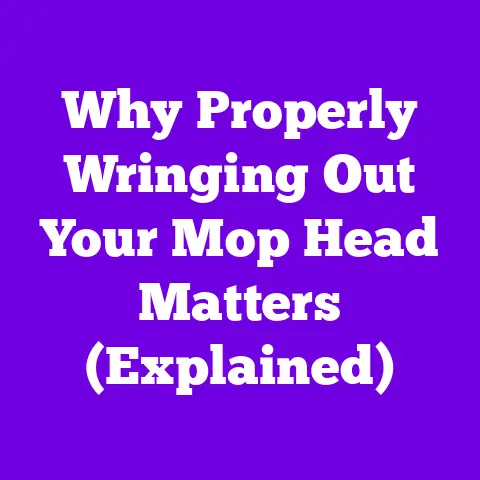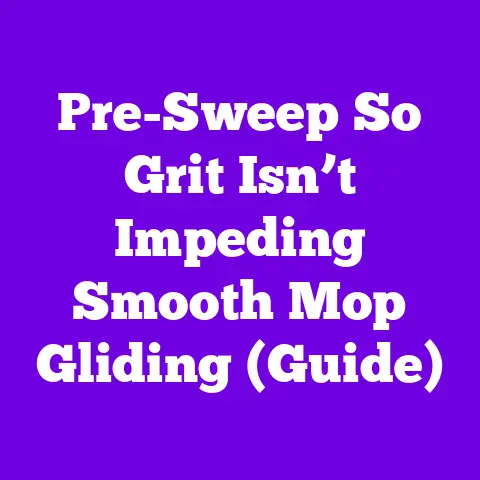Softening Your Roller Mop Head Without Struggle (New & Old)
To soften your roller mop head, you can use a tougher cleaner solution like bleach, soak it in hot water, or add fabric softener during soaking. If the mop head is old and not softening, consider replacing it with a new refill, and you may also opt for a mop with a scrub brush for better cleaning results.
Have you ever grabbed your roller mop motivated to get that perfectly clean kitchen floor?
Realizing its sponge head was hard as a rock with grime. Then thinking, no worries I’ll grab a new refill.
But despite yourself, you find the new head almost as hard as the used one.
This is the dilemma every cleaner has come across. Not to worry though, these tips will help you have softened the sponge head on your roller mop.
That way it is ready to clean every time.
Key Takeaways
- Softening mop heads with fabric softener sheets restores flexibility and ensures smooth gliding across surfaces.
- There are multiple methods for softening mop heads, including using fabric softener sheets, soaking in warm water and vinegar, and utilizing a steam cleaner.
- A softer and more pliable mop head allows for better maneuverability, improves cleaning effectiveness, and reduces strain on wrists and arms.
- Tips for maintaining a soft mop head include regular cleaning, proper drying and storage, and avoiding harsh chemicals or bleach.
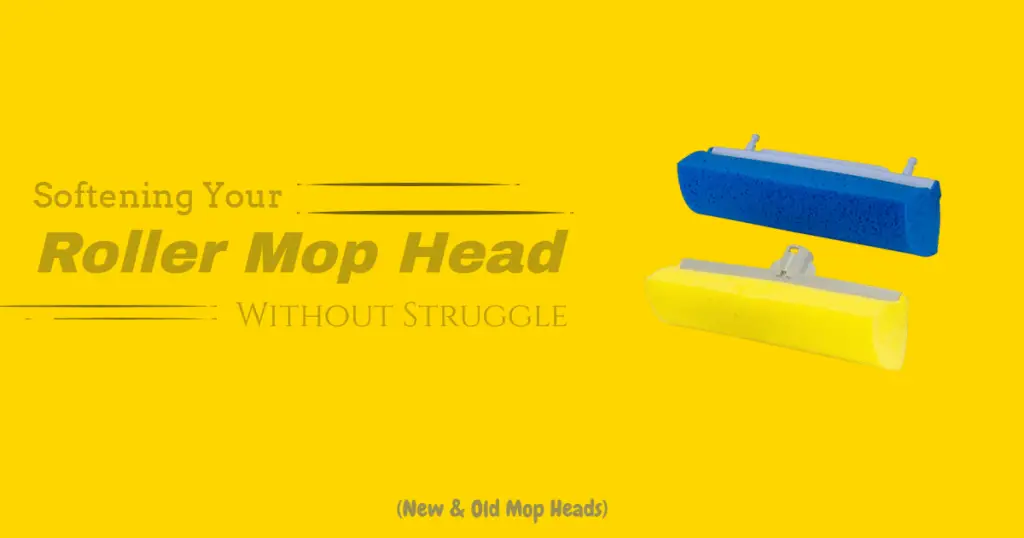
Softening the new Mop Head
When you get your new roller mop head attachment. You’ll notice two things.
One, the sponge is so clean you almost don’t want to dirty it.
Two the mop head is extremely rigid; it doesn’t want to work properly.

The sponge doesn’t give the impression that it is scrubbing in the small crevices of the tile.
You want to make sure your mop head is soft enough to go into the crevices on your floor.
Before you load your new mop head onto the handle. Have your water bucket ready to prepare the new sponge head.
Your water bucket should be filled with hot water.
Preferably the water should be 120 degrees Fahrenheit or more. Mix in the cleaner of your choice.
Once that is done, load the new mop head to the handle. Double-check that the head is securely on.
Nothing is worse than fishing for a sponge in hot water because it slips off the handle. Dunk your mop head in the water.
Leave the sponge submerged for about five seconds. Pull your mop out of the water to wring it out.
Do this 3 or 4 times to ensure the new mop head is softening.
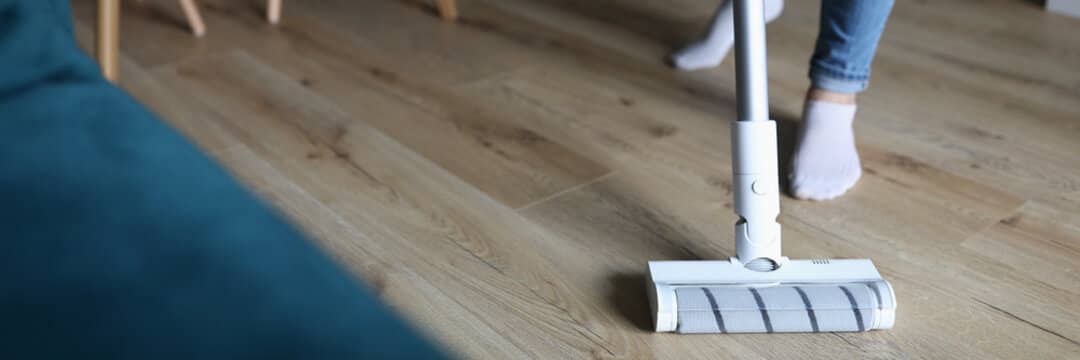
By using this method of softening your roller mop head should stretch and break in the fibers.
This will provide you with a softened sponge that will fit into the grooves on your flooring.
If the roller mop head is made of cotton fiber, then let it soak closer to 10 seconds per round.
While if you have a micro-fiber head, then the 5 seconds per round should be sufficient.
Tip: If your old mop is very hard and you cannot soften it by any means, you can re-use or recycle it for other uses instead of mopping. Don’t throw it into a dustbin.
What is This Build Up?
As you use your mop several times, you may find that the rigidity is plaguing your mop head again.
You may even try the steps above yet find little success.
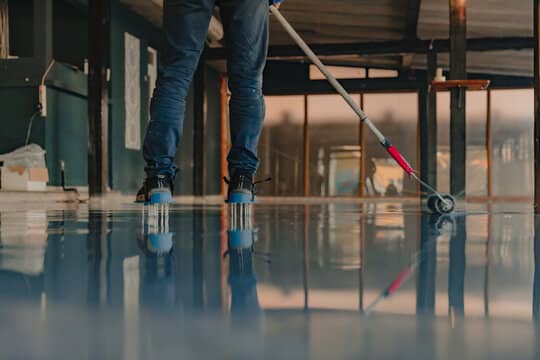
Before you throw away the now hard mop sponge, there are a few softening tips to bring back the life your mop head once had.
When you notice your mop’s head has an oily residue that is causing the hardness. Fill your mop bucket with the following diluted mixture.
1 to 2 cups of white cleaning vinegar per gallon of hot water. Once again, you want the water to be 120 degrees Fahrenheit or more.
Let your mop head soak in the solution for several minutes before wringing it out.
Do these steps 3 or 4 times to make the mop not only soften but get clean so it will stay soft.
Let your mop airdry in a window seal that gets a few hours of sunlight or even better place it outside to dry in the sun.
This should quickly soften a slightly worn roller mop head.
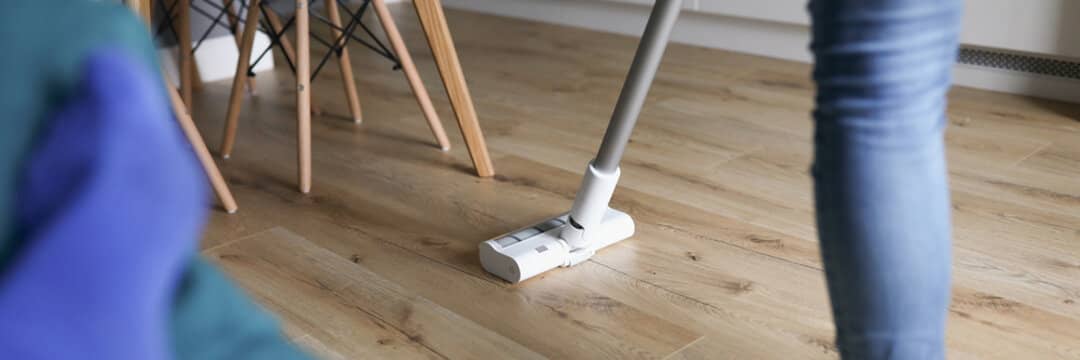
If no natural sunlight is available, leave your mop out to let it have a few hours of air circulation before placing it in a closet.
If this does not do the trick. You will want to soften your mop head with a tougher cleaner solution, such as bleach.
When using a bleach solution 1 cup per 1 gallon of water should be acceptable in softening your mops sponge head.
Do not leave your mop to soak overnight, as that will potentially ruin your mop.
The excessive amount of moisture could also lead to bacterial growth within the mop.
Remember, our goal is to soften our mop sponge not invite a family of micro-organisms into our home.
Soaking the Roller Mop Head in Warm Water
The roller mop head can be softened by soaking it in warm water. This simple step is crucial for achieving efficient and effective cleaning results. Warm water helps to loosen dirt, grime, and residue that may have accumulated on the mop head during use.
By softening the roller mop head in warm water, you are ensuring a deep cleaning experience that leaves your floors looking spotless. Incorporating this step into your regular cleaning routine will help maintain the longevity and efficiency of your cleaning tools.
To further enhance the cleaning process, consider adding a small amount of soapy water or a gentle detergent to the warm water solution. Additionally, using a microfiber cloth or floor mop specifically designed for ceramic tile can provide superior results when combined with the softened roller mop head.
Adding Fabric Softener to the Soaking Water
To enhance the absorbency of the roller mop, fabric softener can be added to the soaking water. Fabric softener is commonly used in laundry to make clothes feel softer and more comfortable. However, it can also benefit cleaning tools such as roller mop heads.
By adding fabric softener to the soaking water, the roller mop head becomes softer and more pliable, making it easier to clean surfaces effectively. The softened roller mop head is able to hold more water and cleaning solution, resulting in a larger floor coverage area with each swipe.
Additionally, fabric softener helps maintain the mop’s overall quality by preventing it from becoming stiff or brittle over time. This ensures that the roller mop continues to provide a highly absorbent and efficient sweeper for reliable cleaning performance.
Using a Steam Cleaner to Loosen the Fibers
Using a steam cleaner can effectively loosen the fibers of the roller mop head. This method is particularly useful for mops made of materials such as rubbermaid commercial products or Ocedar microfiber mop, which tend to become stiff over time.
Here are some reasons why using a steam cleaner can be beneficial:
- Enhanced cleaning power: The high temperature and pressure generated by the steam cleaner help to break down dirt, grime, and stains trapped in the mop head fibers.
- Time-saving: Steam cleaning eliminates the need for vigorous scrubbing or soaking, reducing the amount of time and effort required to soften the mop head.
- Versatility: Steam cleaners can be used on various cleaning tools and laundry items, making them a versatile addition to your cleaning arsenal.
- Suitable for different surfaces: Whether you have a tile floor or bathroom tiles, a steam cleaner can effectively loosen the fibers of your roller mop head without causing damage.
By incorporating a steam cleaner into your cleaning routine, you can effortlessly restore your mop’s softness and maintain its cleaning efficiency.
Applying a Mixture of Vinegar and Water
Applying a mixture of vinegar and water can effectively break down residue and restore flexibility to the fibers of a roller mop head. This method is particularly useful for removing pet hair, dust bunnies, and other debris that may accumulate on the mop head during floor mopping. To prepare the solution, mix one cup of water with one cup of vinegar in a spray bottle or bucket.
Vinegar acts as a natural cleaning agent and helps to dissolve stubborn dirt and grime while also eliminating odors. When using this mixture, it is important to ensure that the roller mop head is thoroughly saturated with the solution before starting to mop. Additionally, this technique works well on smooth surfaces such as bathroom tiles where cotton mops or swiffer sweepers may struggle to reach into crevices.
Overall, incorporating vinegar and water into your cleaning supplies can be an effective way to soften your roller mop head and maintain an efficient and effective cleaning tool.
Using a Mop Head Softening Solution
An alternative method for maintaining the effectiveness of a roller mop head involves the use of a specialized solution. This solution is specifically designed to soften the bristles of the mop head, making it easier to clean and ensuring better absorption of liquid.
By using this solution, users can effectively clean various surfaces, including bathroom showers, industrial spaces, and commercial areas. The pliable bristles result in an enhanced cleaning experience compared to mops with stiff bristles.
Additionally, this solution is particularly useful for reaching tighter spaces where larger lobby brooms may not be effective. It also helps extend the lifespan of the mop head by preventing wear and tear caused by regular use.
Overall, incorporating a mop head softening solution into your cleaning routine can greatly improve your cleaning efficiency and results.
Brushing the Mop Head with a Soft Bristle Brush
Brushing the mop head with a soft bristle brush helps to maintain its cleanliness and ensure optimal performance. The fine bristles of a soft bristle brush effectively remove dirt, dust, and debris from the mop head, preventing them from accumulating over time. This is particularly important for roller mop heads that are used as everyday sweepers in high-traffic areas such as kitchens.
By regularly brushing the mop head, it remains free from mold and mildew, ensuring maximum floor coverage during cleaning. Additionally, brushing helps to preserve the integrity of the mop head’s fibers or loops, which are designed to attract and retain dust particles efficiently. This ensures that the cotton blend material of the mop head can tackle spills effectively while remaining durable for long-term use.
Brushing also removes any lint or loose fibers that may have accumulated on the mop head after laundering, allowing it to function optimally as one of your essential laundry items or kitchen accessories.
Massaging the Mop Head with Your Hands
Moving on from the previous subtopic, another method for softening your roller mop head is by massaging it with your hands. This technique involves using the natural warmth and pressure of your hands to loosen any hardened residue or debris that may have accumulated on the mop head. By gently rubbing and kneading the fibers, you can help restore their original softness and flexibility.
This method is particularly useful for removing extra hair or lint that may be trapped in the mop head. Additionally, massaging the mop head allows you to inspect it more closely for any signs of wear or damage, ensuring its longevity as a cleaning tool in your arsenal.
Once softened, ensure proper storage by hanging the mop upside down through its storage loop or placing it in a well-ventilated area away from moisture or heat sources such as a clay sink or copper sink. Remember to keep your cleaning tools separate from other laundry items or kitchen utensils to maintain hygiene and prevent cross-contamination.
Wrapping the Mop Head in a Damp Towel Overnight
To facilitate the softening process, one effective method involves wrapping the mop head in a damp towel overnight. This technique allows the moisture from the towel to penetrate and hydrate the mop fibers, resulting in a softer texture that is easier to maneuver during cleaning.
The dampness of the towel creates a humid environment around the mop head, promoting absorption and retention of moisture. As a result, the mop fibers become more pliable and supple, reducing resistance while mopping floors.
Furthermore, leaving the mop head wrapped in a damp towel overnight allows for an extended period of time for optimal softening effects to take place. By implementing this method, individuals can achieve a softened roller mop head without any struggle or additional effort required during their cleaning routine.
Using a Fabric Softener Sheet on the Mop Head
Using a fabric softener sheet on the mop head can provide an additional method for enhancing its texture and maneuverability during cleaning tasks. Fabric softener sheets are typically designed to reduce static cling and soften fabrics in laundry, but they can also be beneficial for softening and improving the performance of a roller mop head.
The chemicals present in the fabric softener sheet help to break down any residue or stiffness that may have accumulated on the mop head over time. Simply rubbing the fabric softener sheet onto the mop head before use can help to restore its flexibility and ensure smooth gliding across surfaces.
This technique is particularly useful for those who prefer a softer, more pliable mop head that effortlessly moves along floors, making cleaning tasks easier and more efficient.
Maintenance Habits to Ensure a Soft Roller Mop
Initially softening the roller head mop isn’t very labor-intensive however it is not the only answer.
Maintaining the softness will help the roller mop’s longevity along with saving you time in the future.
When scrubbing your floors, you will notice the water is getting beyond dirty. Dump it out!

When your water bucket is so dirty you don’t even recognize the color. The water is not the only thing that is getting beyond dirty.
Your mop’s sponge head is not able to release all the dirt particles when you wring it out if the water is that dirty.
This will cause not only the mop to retain the dirt but the fibers are hardening even while you are cleaning.
Don’t forget to store brooms and mops properly. You can check and follow the manual that comes with it for instructions.
Remember you want the fibers of your mop head to always be at their highest cleaning power. This will ensure a clean home.
After every mop session, dump out the bucket you were using to clean your floors. Make sure the bucket has no residue or gunk in it.
Refill the bucket with either vinegar or bleach solution, as referenced above. You want to avoid using your floor cleaner mixture here.
Your floor cleaner may have oils that will “clog” up the mop head, causing a hard mop sponge. Bleach and vinegar naturally cut through grease.
By using bleach/vinegar you will protect your sponge from hardening.
When you are in a pinch for time and can’t leave your mop out to dry. Do not place it in your empty mop bucket.
Even if the bucket is dry. This will cause your mop head sponge to be pinched inside the bucket.
You want the sponge fibers to “breathe”. The sponge head has to have a slight amount of airflow.
By allowing your sponge the opportunity to “breathe”, it will keep the sponge soft along with extending its usable life.
Frequently Asked Questions
Is it necessary to soak the roller mop head in warm water before using it?
Soaking the roller mop head in warm water before use is not necessary. The softening process can be achieved by simply wetting the mop head and allowing it to absorb moisture naturally.
Can I add fabric softener to the soaking water to further soften the mop head?
Adding fabric softener to the soaking water may further soften the mop head, enhancing its cleaning performance. However, it is essential to consider potential adverse effects such as residue build-up or decreased absorbency.
How effective is using a steam cleaner to loosen the fibers of the mop head?
Using a steam cleaner can effectively loosen the fibers of a mop head. The high temperature and moisture from the steam help to soften and relax the fibers, making it easier to clean and maintain the mop head.
What is the purpose of applying a mixture of vinegar and water to the mop head?
The purpose of applying a mixture of vinegar and water to the mop head is to break down any residue or build-up, disinfect the mop, and remove any unpleasant odors, resulting in a cleaner and fresher mop.
Is there a specific mop head softening solution that works best, or can any solution be used?
Any solution that effectively softens the mop head can be used. However, it is recommended to use a solution specifically designed for this purpose, as they are formulated with ingredients that break down residue and restore the mop head’s softness more efficiently.
Final Words
In conclusion, softening your roller mop head can be achieved through various methods. These include soaking it in warm water with fabric softener, using a steam cleaner to loosen the fibers, applying a mixture of vinegar and water, or using a mop head softening solution.
Additionally, brushing the mop head with a soft bristle brush or massaging it with your hands can also help to soften it. For overnight softening, wrapping the mop head in a damp towel is recommended.
Lastly, using a fabric softener sheet on the mop head can provide an added touch of softness. Softening your roller mop head is like giving it a gentle massage that leaves it feeling rejuvenated and ready for its next cleaning task.

